Attention! This is a test. This is a test of the Barn Finds Emergency Vehicle Identification Team. This is a test to see if the readers of Barn Finds can verify that this vehicle is actually a 1927 model GMC truck. The owner of this truck thinks that this is a 1927 model, but also states that it could be anywhere from a 1923 to a 1928 model. He is currently selling this truck on eBay with a starting bid of $20,000. This truck, which is also missing its water pump, is waiting for a buyer in Austin, Texas.
I have to admit that I am failing this test. While I have been to numerous car shows across the eastern United States, I haven’t seen many commercial grade trucks from this era. These types of vehicles show up at the Antique Automobile Club of America’s Hershey swap meet every October, but they are almost non-existent everywhere else. These trucks are too slow to drive to a show, often too big or bulky to trailer behind a conventional pickup, and are hard to find parts for. They were used mainly for commercial applications such as for deliveries, moving heavy items, fire equipment, and for construction. The survival rate on these is low because they were both used up when their owners finished using them and because of the large amount of time that has passed since their production made them perfect candidates for deterioration. Most of the ones that survived until the World War II era were probably lost to scrap drives.
The plate in the picture above gives you a good idea how these trucks were used. The engines in these trucks were weak and low revving by modern standards. They didn’t have a lot of horsepower, but they did have a fair amount of low speed torque. These engines, combined with very low gearing, allowed these trucks to haul very heavy loads. This truck, which weighed around 5,500 pounds, could carry another 5,000 pounds according to its weight rating. The penalty for all that pulling power was a very low top speed of 18 miles per hour. Obviously, you did what you could with what you had back in the day.
As you can see from the picture above, the chassis on these trucks are built to take a lot of abuse. The gearing is similar to what you might see on some modern construction equipment, as it looks like some sort of worm and screw arrangement. The multi leaf springs are designed to carry a lot of weight, and even the trailing arms are of an I beam type construction. Surprisingly, the tires are pneumatic. A lot of old trucks of this type came with solid rubber tires. While I am sure they rode hard, solid rubber tires did rid you of the chance of a flat. At 18 miles per hour, ride quality wasn’t a big concern either.
Instrumentation and driver comfort wasn’t a big concern either. In the lower right corner is an oil pressure gauge, and in the upper right hand corner is an ammeter. The rest of the stuff I am unsure about. I think the handle to the right is a parking brake, and the floors appear to be simple wooden panels. The holes in the cowl on the right suggest that some sort of body was attached, but it is obviously long gone now. This could be a good thing. Just like buyers back then, you could order a chassis and either make or have a body made to suit your particular needs.
Under the hood, you can see one reason why these trucks were so slow. If you look carefully, rust pitting has been cleaned up on the cylinder head and underneath the hood. This damage could probably be made to disappear with some high build primer and some sanding, but it gives you a good idea of the rough life these trucks lead both during and after their service. Also notice the oil can on the firewall. Lubrication schedules were a little more frequent back then, and these cans are a common sight on vehicles made before 1930.
This truck reminds me of an overlooked, yet important piece of military history. In 1919, the US Army decided to test the feasibility of transferring equipment from one coast to the other in the event of war. On this trip was a young Lieutenant Colonel named Dwight Eisenhower. His experiences on this grueling trip across a country with no real transcontinental road network gave Eisenhower a real lesson in logistics. The trip was plagued by numerous breakdowns, problems, and situations where they literally made their own road. Eisenhower wrote about the trip in his autobiography, and the impression the trip made on him (along with that of the autobahn in Germany) paved the way for the Interstate Highway System when he became president. If you look at the design of trucks like this, you can see the reasons why ground clearance was high, gearing was low, and tires were narrow. All of these design features were needed because the roads we had back then were largely unpaved and many were difficult to travel, especially in inclement weather.
The pictures above, made available to us from the Eisenhower Presidential Library website, show just how tough trucks such as this had to be during their service life. While the actual year of the truck being sold is somewhat of a mystery, the bigger question is what happens to it now? The owner wants $20,000 for it, and I think that would be a difficult number to reach for a truck that looks like it was a half finished restoration from a number of years ago. He states in the ad that it was running, and that he has a box of parts and the steering wheel, but little additional information is given. These trucks don’t offer many of the rewards that a standard collector car can, but they are an important part of our history. Perhaps someone can justify purchasing it and using it for advertising a long standing business. It would be a shame for this truck to never see the road again. With a little work, it would be an amazing rolling history lesson.
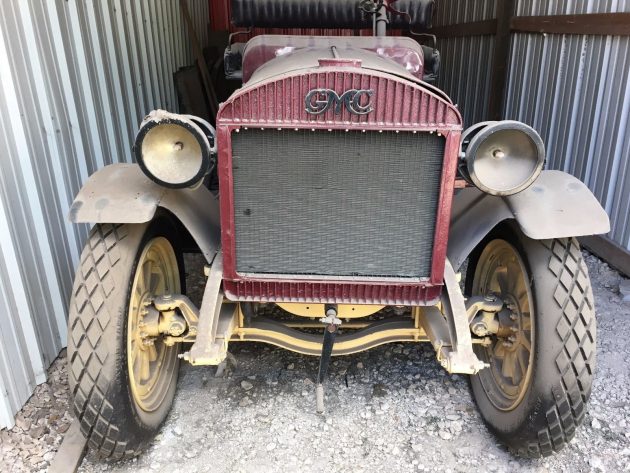
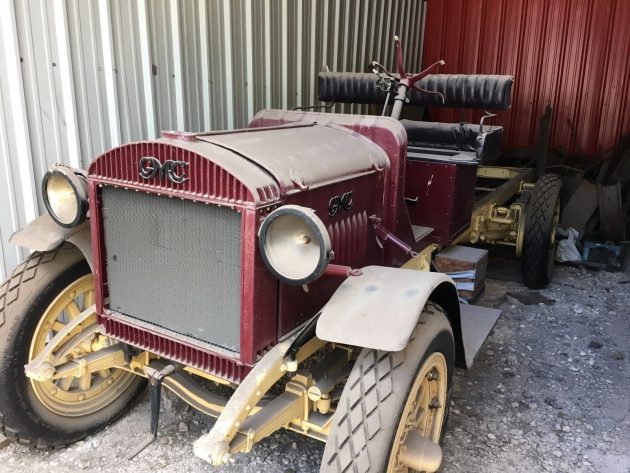
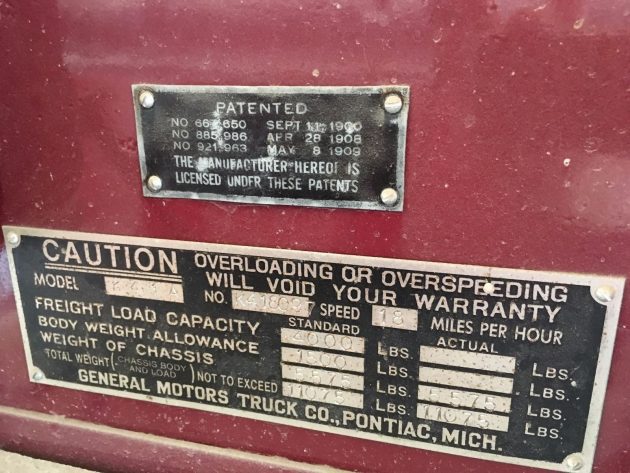

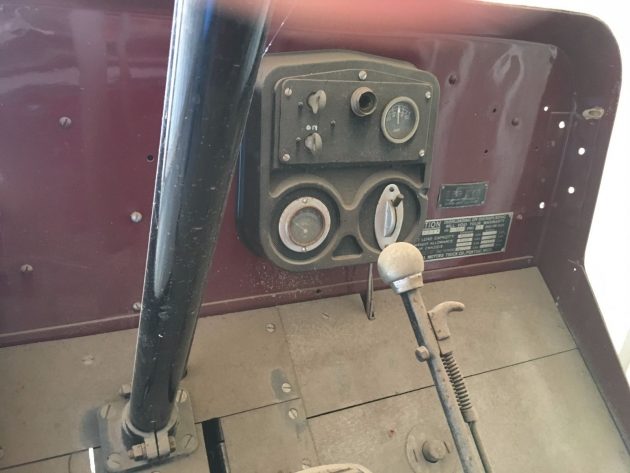
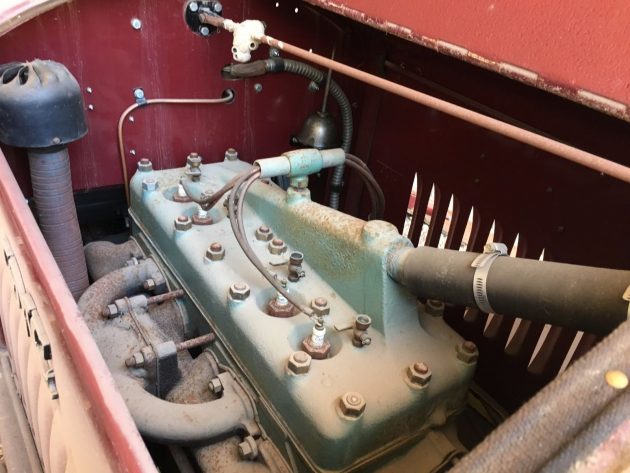

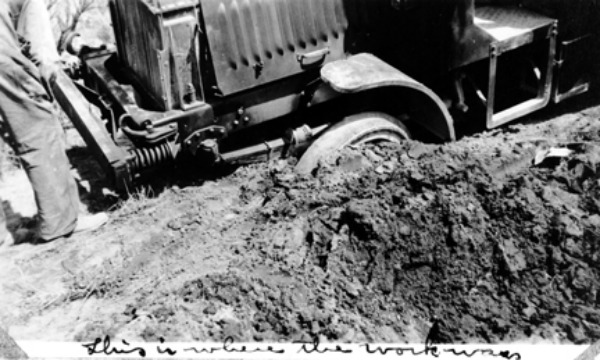





I also noticed a wasp nest on the hood support rod. Best get some of that long range wasp killer spray.
Just a mud dauber nest, which looks vacated and long hatched larvae gone.
Unfortunately, I have a lot of experience taking out wasp nests. This is best done at dusk when all the wasps are in the nest. One good shot from a spray bottle, and its over.
I know nothing about the truck, but I love looking at old vehicles and equipment.
Your inclusion of Eisenhower’s story and why he was determined to create the interstate system reminded me of another bit of transportation history… that the booster rockets on the Space Shuttle were designed based on the width of a horse’s ass…
http://www.astrodigital.org/space/stshorse.html
Well, it can’t be any newer than a ’27. Apparently, in ’28, they went with a chrome grill surround. http://c1.staticflickr.com/4/3757/9439275095_be4d7c309f_b.jpg
They did use this style back to 1922, from what I found. As is, I don’t think it’s too heavy to cart around behind a pickup. Certainly, like Jeff sez, nothing you’d want to drive, but it should be on display. This was state of the art in 1927. The pneumatic tires are definately a plus, as they did improve the ride somewhat. While solid tires don’t go flat, I have heard of solid tires losing big chunks of rubber( like that shopping cart with the flat wheel) How’d you like to finish your day with that? Here’s one we all can agree, keep it original.
Similar to my 1920 Packard truck. Eisenhower had several different brand and styles of truck on his cross country run. In his after action report he described the Packard as “perfect”. The best way to establish the year on some of these old rigs that production information is not available on, is to compare serial numbers from like vehicles with known build dates. I am not sure the Pneumatic tires are original to the chassis……hey could have been……but the first commercial pneumatic truck tires were made by Goodyear and installed on Packards. They raised the top speed from about 20 MPH to over 30 just with there installation. With the data plate specifying 18 MPH, it might have originally had hard tires. This truck Is a medium duty vehicle, not a lot bigger than a pickup. I always wanted to do a WW1 vintage truck as my grandfather drove them in France. Was a little disappointed to find mine was a bit later version but it is very close to the Packards sent to France. I have the Wheels of time magazines (the antique truck club magazine) from the last 20 years or so……guess I need to get into them and see what I can learn about this old girl. I like GMC’s a lot………we are building new frame rails for my Packard. The originals have so many work hardening cracks that they are not useable. I am worried if we repair them they will just crack again and they are so simple, I am building new ones from modern steel.
Heck– it’s NOT a truck, it’s a WALKABOUT a predecessor to a RUNABOUT and before the speedster we just can’t see the boattail rear
~(P
Early trucks are a lot of fun to use, but one REALLY has to get their head around the world they were built for and road conditions back then. They do not go fast, they have less than zero creature comforts, and did I mention, they go really slow?
What they do have is a charm that cars just do not have. I drive a 1925 TT Ford all the time, and only put it away during the snow months (usually when I schedule bigger work on it). With “Express Gears”, it can do almost 40. “Farm Gears” top out around 20. With an auxilliary transmission that has overdrive gears, I am told a comfortable 50+ is possible. But one must never lose sight of the VERY limited braking potential these have, and the general physics of propelling a vehicle like this at those speeds. Being rearended is a constant concern as well. With all the aerodynamics of a phone booth, they just weren’t made to slice the wind like newer trucks. But they are cute and cool like nothing else. I love my truck !
Did you see the recent Jay Leno’s garage? He was driving his similar vintage Autocar on the road……was fun to see.
According to what I can find in the Standard Catalog of American Light Duty Trucks, this appears to be a 1923 model, 1-ton chassis, by radiator and hood design. The same book says there were no 1927 GMC’s and that MAYBE they were based on Pontiac running gear. This history is in contention, however.
The illustration for the 1923 model suggests balloon tires, not solids. I’d go with 1923 as a model year for this truck.
With the ‘ridges’ on the radiator, it might be a Vanden Plas edition?
The brass oil or fuel filler taps on each cylinder (on the head) would indicate to me it is much earlier than 1927 and Waynard above is most likely correct. Note that if the seat is original, it looks pre-1920s.
While no GMC expert, the bare, cast radiator is very suggestive of an earlier vintage. I can think of Macks, REO’s, Federals, and Hugs of the 20’s that look much more streamlined. This old dog looks like that basic vehicle that is all function, with no concern for styling. Something very pre-1920 for most makers.
I have a 1929 GMC Fire Engine. It’s built on a T-30 GMC chasis. I would think this truck is older than mine and would place is somewhere around 1923 – 1925.
There is currently a very similar looking GMC involved in an internet auction in Forks, Washington (along with a LOT of other early trucks).
Great write-up, Jeff. I hadn’t heard the Eisenhower story before. Thanks for the history lesson!
For some reason, first glance made me think of a Marmon.
Another great antique mark……….
Waynard (above) is in my opinion the closest here, but this truck is obviously larger than a one ton. The radiator is probably exactly like the ’23 model, but the suspension is different between this vehicle and the ’23. I believe this is a 1922.
’22 shows a different radiator, and anything above a one-ton appears to have a much higher stance. I’m wondering is this isn’t partly scabbed together with non-matching parts, including the tags. Very hard to tell.
Another blur as to what year it is shows up in when it was made versus when it was first sold to a customer.
I bought a ’52 GMC which was titled as a ’53 because that was when it left the dealer.
That truck is a 1923 GMC K41A model based on the 8097 serial number. By 1928 solid tires were all but gone.